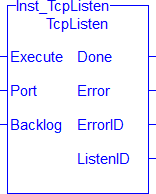TcpListen
![]()
 Function Block
Function Block![]() A function block groups an algorithm and a set of private data. It has inputs and outputs. - Creates a new socket by performing the bind and listen operations.
A function block groups an algorithm and a set of private data. It has inputs and outputs. - Creates a new socket by performing the bind and listen operations.
Inputs
|
Input |
Data Type |
Range |
Unit |
Default |
Description |
|---|---|---|---|---|---|
|
Execute |
BOOL |
0, 1 |
N/A |
No default |
On the rising edge |
|
Port |
DINT |
N/A |
User units |
No default |
The network port to use. |
|
Backlog |
DINT |
N/A |
N/A |
No default |
The size of the queue for pending connections. If more than Backlog number of connection attempts are made prior to a TcpAccept call, the controller may refuse the connections. |
Outputs
|
Output |
Data Type |
Range |
Unit |
Description |
|---|---|---|---|---|
|
Done |
BOOL |
|
|
If TRUE, the command completed successfully. |
|
Error |
BOOL |
|
|
If TRUE, an error has occurred. |
|
ErrorID |
DINT |
|
|
Indicates the error if Error output is TRUE. See the table in Search IndexFile and TCP/IP Function Block ErrorIDs. |
|
ListenID |
UDINT |
|
|
The ID of the new listen socket. |
Remarks
- This function block uses the default TCP settings.
- Use the TcpClose function block to release the socket returned by TcpListen.

Figure 6-283: TcpListen
FBD Language Example
Not available.
FFLD Language Example
Not available.
IL Language Example
Not available.
ST Language Example
(* TcpListen example *)
CASE StepCounter OF
0:
Inst_TcpListen(TRUE, 1234, 2);
StepCounter := StepCounter + 1;
1:
Inst_TcpListen(TRUE, 1234, 2);
IF Inst_TcpListen.Done THEN
MyListenID := Inst_TcpListen.ListenID;
Inst_TcpListen(FALSE, 0, 0);
StepCounter := StepCounter + 1;
END_IF;
END_CASE;
See Also






